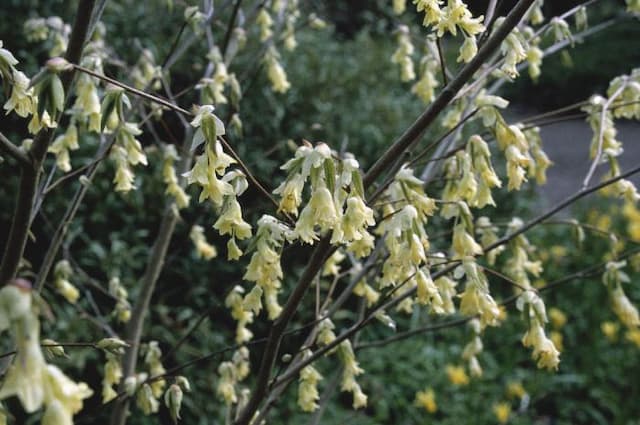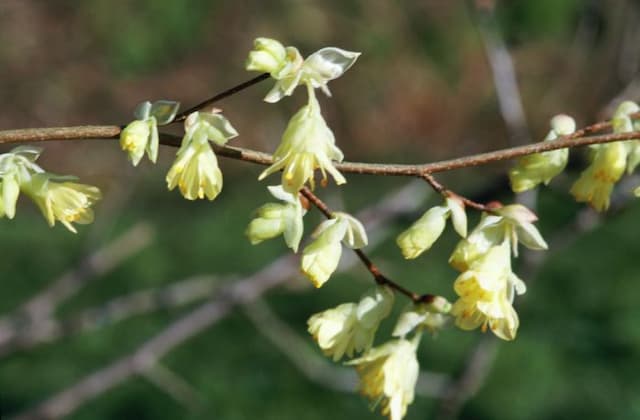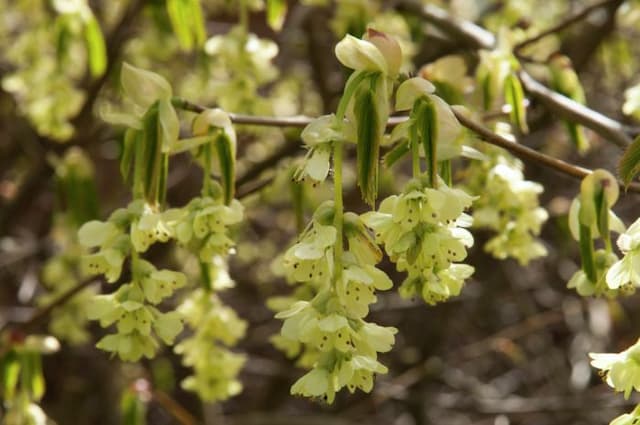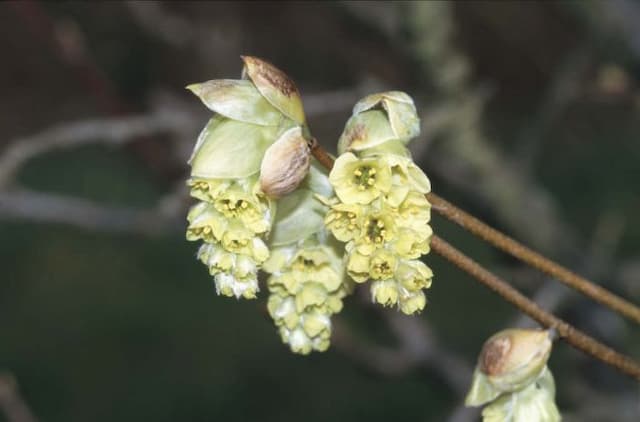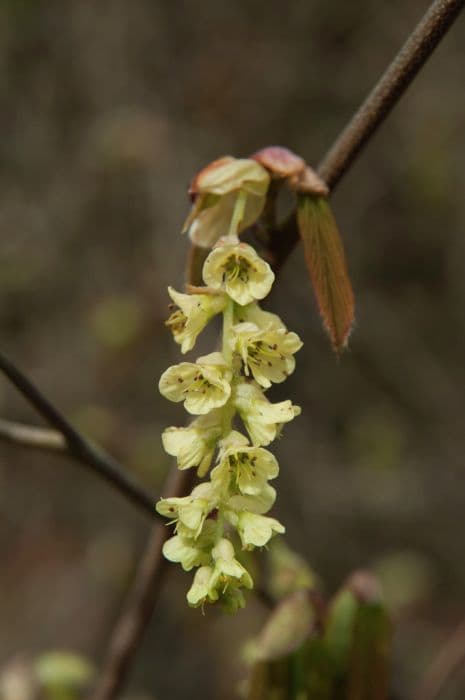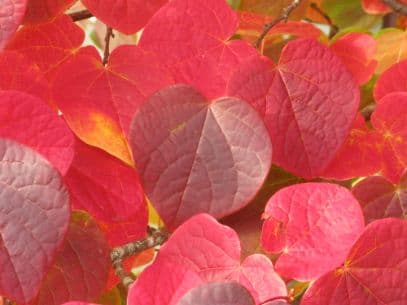Witch hazel Hamamelis × intermedia 'Jelena'

ABOUT
'Jelena' is a cultivar known for its unique and striking flowers which appear in the winter and early spring. The flowers are fragrant and have a distinctive ribbon-like appearance, with petals that curl slightly, showcasing a warm blend of copper to orange tones. These blossoms are borne on bare branches before the leaves emerge, making the floral display particularly eye-catching against the starkness of winter. The foliage arrives later in the season, emerging in a fresh green color. These leaves are broadly oval in shape, and they usually display a wavy or slightly twisted texture, adding to the ornamental appeal of the shrub. As the seasons transition to autumn, the leaves take on striking colors, with a palette that may include yellow, red, and sometimes purple, contributing to the plant's multi-season interest. Overall, the 'Jelena' cultivar presents a harmonious blend of distinctive flowers and attractive foliage that changes with the seasons, making it an appealing choice for gardeners seeking year-round interest.
About this plant
 Names
NamesFamily
Hamamelidaceae
Synonyms
Witch Hazel, Jelena Witch Hazel
Common names
Hamamelis × intermedia 'Jelena'.
 Toxicity
ToxicityTo humans
Witch Hazel 'Jelena' is generally considered non-toxic to humans. There is no widespread documentation of poisoning from ingesting this plant, and it is commonly used in skincare and medicinal products for its astringent properties. However, it is always wise to avoid eating ornamental plants as a precaution.
To pets
Witch Hazel 'Jelena' is typically non-toxic to pets. There is little evidence to suggest that pets, such as cats and dogs, would suffer from poisoning after ingesting parts of this plant. However, as with humans, it's always best to prevent pets from consuming plants not intended for consumption.
 Characteristics
CharacteristicsLife cycle
Perennials
Foliage type
Deciduous
Color of leaves
Green
Flower color
Coppery-orange
Height
10-15 feet (3-4.6 m)
Spread
10-15 feet (3-4.6 m)
Plant type
Shrub
Hardiness zones
5-8
Native area
Japan China
Benefits
 General Benefits
General Benefits- Attractive Flowers: 'Jelena' witch hazel produces coppery-orange to red fragrant flowers that add color to the winter landscape.
- Seasonal Interest: Offers multi-season appeal with its vibrant fall foliage and winter blossoms.
- Wildlife Attraction: The flowers provide nectar for pollinators that are active in late winter like bees when few other plants are in bloom.
- Low Maintenance: Once established, it requires minimal care, making it suitable for gardeners of all skill levels.
- Adaptable: It can adjust to a variety of soil conditions, though it prefers well-draining, acidic soil.
- Drought Tolerance: Exhibits some drought resistance when mature, reducing the need for frequent watering.
- Architectural Interest: With its vase-shaped form, it can serve as a focal point or accent in garden design.
 Medical Properties
Medical PropertiesThis plant is not used for medical purposes.
 Air-purifying Qualities
Air-purifying QualitiesThis plant is not specifically known for air purifying qualities.
 Other Uses
Other Uses- Photographic Subject: The Witch Hazel 'Jelena' with its vibrant orange to copper flowers is often used by photographers as a subject for botanical photography, especially for capturing the beauty of winter-blooming plants.
- Natural Dye: The flowers and bark of Witch Hazel can be used to create natural dyes for fabric, yielding colors that range from yellow to reddish-brown depending on the mordant used.
- Winter Garden Interest: Witch Hazel 'Jelena' is commonly used in winter gardens to provide color and interest during the usually bleak winter months, with its unique flowers that bloom at a time when few other plants do.
- Culinary Flavoring: Although not common, the petals of Witch Hazel can be used in small quantities to infuse water or spirits with a subtle flavor, taking care to use non-sprayed plant parts.
- Artistic Inspiration: The unusual structure and color of Witch Hazel 'Jelena' flowers serve as inspiration for artists and can be found in various forms of art from watercolor paintings to textile patterns.
- Water-wise Landscaping: As a plant that is tolerant of various soil conditions and once established is drought-tolerant, Witch Hazel 'Jelena' can be used in xeriscaping, contributing to conservation of water in landscaping.
- Crafting: The branches and seed pods of Witch Hazel can be dried and used for making craft items, such as wreaths and dried flower arrangements, especially in autumn and winter.
- Privacy Screening: With its broad spreading habit, Witch Hazel 'Jelena' can be planted in rows to create a natural privacy screen while also adding aesthetic value to a space.
- Attracting Wildlife: Witch Hazel 'Jelena' can provide a valuable source of nectar for bees and other pollinators that are active during the late winter months, thus enhancing biodiversity in gardens.
- Educational Tool: In botany and horticulture education, Witch Hazel 'Jelena' is often used to demonstrate plant adaptation, phenology, and pollination strategies, particularly in relation to winter-flowering species.
Interesting Facts
 Feng Shui
Feng ShuiThe Witch Hazel is not used in Feng Shui practice.
 Zodiac Sign Compitability
Zodiac Sign CompitabilityThe Witch Hazel is not used in astrology practice.
 Plant Symbolism
Plant Symbolism- Resilience and Survival: Jelena Witch Hazel blooms in late winter, often while snow is still on the ground, symbolizing the ability to endure and overcome challenging conditions.
- Healing and Comfort: Witch Hazel is well-known for its therapeutic properties, and it is commonly used in skincare and medicinal remedies, symbolizing healing and the soothing of troubles.
- Unique Beauty: The distinctive, fragrant flowers of Jelena Witch Hazel, with their spider-like petals, symbolize uniqueness and stand out in the bleak winter landscape, representing the idea that beauty can be found in unexpected places and times.
- New Beginnings: As one of the first plants to flower in the year, Witch Hazel can symbolize new beginnings and the hope that comes with the start of a new cycle or season.
- Protection: Witch Hazel has been used historically to ward off negative influences and is often associated with protection from harm.
 Water
WaterWitch Hazel 'Jelena' prefers consistently moist soil, so it should be watered deeply whenever the top inch of soil feels dry to the touch. This typically means providing about 1 to 2 inches of water per week, but it can vary with weather conditions—more frequent watering during dry spells and less when it's rainy. During the growing season in spring and summer, keeping the soil evenly moist is crucial. However, reduce watering in the fall and further in winter when the plant is dormant. Instead of a set schedule, always check the soil moisture level to guide your watering. Be sure to avoid waterlogging by ensuring good drainage.
 Light
LightWitch Hazel 'Jelena' performs best when planted in a spot with full sun to partial shade. It can tolerate a range of light conditions but flowering is most prolific in areas that receive at least 4 to 6 hours of direct sunlight daily. Too much shade may result in fewer flowers and a leggier growth habit. The ideal location would provide morning sun and afternoon shade, especially in areas with hot summer climates to prevent leaf scorch.
 Temperature
TemperatureWitch Hazel 'Jelena' is hardy and can withstand a range of temperatures, thriving in USDA hardiness zones 5 through 8. The plant can survive minimum temperatures as low as -20 to -10 degrees Fahrenheit and tolerates summer highs typically up to 86 degrees Fahrenheit. For optimal growth, maintaining an average temperature between 60 and 75 degrees Fahrenheit is ideal, aligning with usual temperate climate conditions throughout the seasons.
 Pruning
PruningWitch Hazel 'Jelena' should be pruned to remove any dead or damaged wood and to maintain its shape. It is best to prune in late winter or early spring before new growth starts, following the blooming period. Pruning at this time allows for shaping of the plant without sacrificing the current year's flowers. Occasional thinning of older stems can also help to invigorate the plant and encourage more prolific blooming.
 Cleaning
CleaningAs needed
 Soil
SoilWitch Hazel 'Jelena' thrives in well-draining, loamy soil with a slightly acidic to neutral pH, aiming between 5.5 and 7. The best soil mix can be created by combining two parts garden soil, one part peat moss, and one part perlite to ensure proper drainage and aeration. Regularly enriching the soil with organic matter will also promote healthy growth.
 Repotting
RepottingWitch Hazel 'Jelena' typically does not need frequent repotting as it is a slow-growing shrub. It can be repotted every 3 to 5 years or when it outgrows its current container. When repotting, choose a container only slightly larger than the previous one to prevent waterlogging.
 Humidity & Misting
Humidity & MistingWitch Hazel 'Jelena' prefers moderate humidity levels but is quite adaptable to different atmospheric moisture conditions. It can handle the humidity levels typically found in temperate climates without needing any special modifications.
 Suitable locations
Suitable locationsIndoor
Place Witch Hazel 'Jelena' near bright window; water moderately.
Outdoor
Plant Witch Hazel 'Jelena' in partial shade; mulch and water.
Hardiness zone
5-8 USDA
 Life cycle
Life cycleHamamelis × intermedia 'Jelena', commonly known as the hybrid witch hazel 'Jelena', begins its life cycle when a seed germinates, typically requiring a period of cold stratification to break dormancy. Once sprouted, the seedling will grow and develop into a young plant, experiencing vegetative growth characterized by the elongation of stems and the production of leaves. During this period, the plant will also establish a strong root system to absorb water and nutrients. As the plant matures, it enters the reproductive stage, producing unique spider-like fragrant flowers that are a deep coppery-orange color, typically blooming in late winter to early spring before the foliage appears. After pollination, the flowers develop into seed capsules that ripen in the fall and eventually open to release seeds, completing the reproductive cycle. This plant also has a phase of seasonal dormancy in the winter months, during which it conserves energy until favorable growing conditions return in the spring.
 Propogation
PropogationPropogation time
Late winter-early spring
The Witch Hazel 'Jelena' is best propagated during the dormant season, specifically late winter or early spring before new growth begins. The most popular method of propagation for this plant is by softwood cuttings. This involves taking a cutting of about 6 to 8 inches (15 to 20 cm) from new growth of the current season. The cuttings should have a few leaves left on them, and the lower leaves should be removed. The cut end is dipped in rooting hormone powder to encourage root development and then inserted into a pot filled with a mix of peat and perlite or a sterile seed-starting mix. The pot is then kept in a warm, humid environment with indirect sunlight and the soil is kept consistently moist. Roots usually develop within 4 to 6 weeks, after which the new plant can be gradually acclimatized to outdoor conditions before planting it out.
